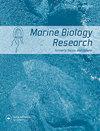Bioengineering by the alien false mussel Mytilopsis sallei (Bivalvia: Dreissenidae) affects small-scale distribution pattern of benthic macroinvertebrates in an estuarine system
IF 1.2
4区 生物学
Q4 ECOLOGY
引用次数: 0
Abstract
ABSTRACT The false mussel Mytilopsis sallei (Récluz, 1849) invaded the Songkhla Lagoon System in southern Thailand more than two decades ago. The false mussel forms dense beds, creating three-dimensional habitat structures on soft substrata which harbour a myriad of organisms. We compare a community of benthic macroinvertebrates in a habitat modified by M. sallei with a community in an unmodified habitat. The study focused on a canal feeding into the southern end of the lagoon system and covered three seasons (north-east monsoon season, dry season and south-west monsoon season) in a 12-month period. A total of 26 taxa were present in the modified habitat and 22 in the unmodified habitat. In the modified habitat, abundances of other byssally attached bivalves, flatworms and some species of amphipods were more than an order of magnitude greater than abundances in the unmodified habitat. Differences in the community composition between habitats were observed but were dependent on sampling location and time. Although the modified habitat hosted greater numbers of species and individuals in most comparisons, the Shannon–Wiener index and Pielou's evenness index were lower for this habitat as it tended to be dominated by a few taxa. The results highlight the role of M. sallei as a habitat engineer that promotes species richness and abundance of some benthic macroinvertebrates. Nonetheless, temporal variation in environmental drivers, especially salinity, might also be important in determining biodiversity in the studied estuarine system.外来假贻贝Mytilopsis sallei的生物工程影响河口系统中底栖大型无脊椎动物的小规模分布模式
摘要20多年前,假贻贝Mytilopsis sallei(Récluz,1849)入侵了泰国南部的宋克拉泻湖系统。假贻贝形成了密集的海床,在柔软的海床上形成了三维的栖息地结构,海床上有无数的生物。我们比较了M.sallei改造的栖息地中的底栖大型无脊椎动物群落和未经改造的栖息地的群落。这项研究的重点是一条流入泻湖系统南端的运河,在12个月的时间里涵盖了三个季节(东北季风季节、旱季和西南季风季节)。改良栖息地共有26个分类群,未改良栖息地有22个分类群。在改良后的栖息地中,其他附带的双壳类、扁虫和某些种片脚类的丰度比未改良栖息地的丰度高出一个数量级以上。观察到栖息地之间群落组成的差异,但这取决于采样地点和时间。尽管在大多数比较中,改良后的栖息地拥有更多的物种和个体,但该栖息地的Shannon–Wiener指数和Pielou均匀度指数较低,因为它往往由少数类群主导。研究结果突出了M.sallei作为栖息地工程师的作用,促进了一些底栖大型无脊椎动物的物种丰富度和丰度。尽管如此,环境驱动因素的时间变化,特别是盐度,可能对确定所研究河口系统的生物多样性也很重要。
本文章由计算机程序翻译,如有差异,请以英文原文为准。
求助全文
约1分钟内获得全文
求助全文
来源期刊

Marine Biology Research
生物-海洋与淡水生物学
CiteScore
2.10
自引率
0.00%
发文量
55
审稿时长
6-12 weeks
期刊介绍:
Marine Biology Research (MBRJ) provides a worldwide forum for key information, ideas and discussion on all areas of marine biology and biological oceanography. Founded in 2005 as a merger of two Scandinavian journals, Sarsia and Ophelia, MBRJ is based today at the Institute of Marine Research, Bergen, Norway. The Journal’s scope encompasses basic and applied research from all oceans and marine habitats and on all marine organisms, the main criterium for acceptance being quality.
 求助内容:
求助内容: 应助结果提醒方式:
应助结果提醒方式:


